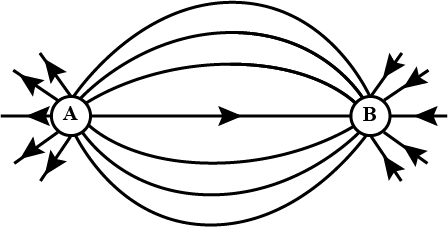
The spatial distribution of the electric field due to two charges (A, B) is shown in figure. Which one of the following statements is correct?

(A ) is +ve and B -ve and \[\left| A \right|{\text{ }} > {\text{ }}\left| B \right|\]
(B) is +ve and B -ve and \[\left| A \right|{\text{ }} = {\text{ }}\left| B \right|\]
(C) Both are +ve but A > B
(D) Both are -ve but A > B
Answer
226.2k+ views
Hint Electric field lines originate from positive charge and settle down in negative charge. A positive and a negative charge is said to create its field around itself.
Complete step-by-step answer:
A single point charge will give out electric field lines, which move away from it till infinity. Similarly, a negative point charge will converge electric field lines coming towards it from infinity. Therefore A is a positive charge and B is a negative charge. Moving onto the second part, \[\left| A \right|\] and \[\left| B \right|\]. Magnitude of an electric charge is measured by the number of electric field lines converging or diverging from it. In our case, the number of electric field lines diverging from A is 12. Similarly for B, the number of electric field lines converging on it is also 12. Therefore, the numbers of electric field lines converging or diverging on the 2 charges are equal and hence their magnitude is also equal.
So, Option B is correct
Note Electric field lines do not form closed loops. They always end up or originate from a source of charge. Also electric field lines do not interfere. If they do, there will be 2 directions of electric field which is not possible.
Complete step-by-step answer:
A single point charge will give out electric field lines, which move away from it till infinity. Similarly, a negative point charge will converge electric field lines coming towards it from infinity. Therefore A is a positive charge and B is a negative charge. Moving onto the second part, \[\left| A \right|\] and \[\left| B \right|\]. Magnitude of an electric charge is measured by the number of electric field lines converging or diverging from it. In our case, the number of electric field lines diverging from A is 12. Similarly for B, the number of electric field lines converging on it is also 12. Therefore, the numbers of electric field lines converging or diverging on the 2 charges are equal and hence their magnitude is also equal.
So, Option B is correct
Note Electric field lines do not form closed loops. They always end up or originate from a source of charge. Also electric field lines do not interfere. If they do, there will be 2 directions of electric field which is not possible.
Recently Updated Pages
JEE Main 2025-26 Experimental Skills Mock Test – Free Practice

JEE Main 2025-26: Magnetic Effects of Current & Magnetism Mock Test

JEE Main 2025-26 Atoms and Nuclei Mock Test – Free Practice Online

JEE Main Mock Test 2025-26: Optics Chapter Practice Online

The work done in slowly moving an electron of charge class 12 physics JEE_Main

The value of the resistor RS needed in the DC voltage class 12 physics JEE_Main

Trending doubts
JEE Main 2026: City Intimation Slip and Exam Dates Released, Application Form Closed, Syllabus & Eligibility

JEE Main 2026 Application Login: Direct Link, Registration, Form Fill, and Steps

Understanding the Angle of Deviation in a Prism

Hybridisation in Chemistry – Concept, Types & Applications

How to Convert a Galvanometer into an Ammeter or Voltmeter

Ideal and Non-Ideal Solutions Explained for Class 12 Chemistry

Other Pages
JEE Advanced Marks vs Ranks 2025: Understanding Category-wise Qualifying Marks and Previous Year Cut-offs

Dual Nature of Radiation and Matter Class 12 Physics Chapter 11 CBSE Notes - 2025-26

Understanding Atomic Structure for Beginners

Understanding Average and RMS Value in Electrical Circuits

Degree of Dissociation: Meaning, Formula, Calculation & Uses

Gyroscope Explained: Principles, Working & Real-World Uses




